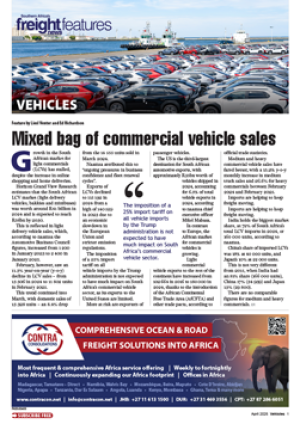ALAN PEAT
ALTHOUGH THERE is always the human element of possible death or injury in road accidents involving heavy commercial vehicles, transport operators also have to take a calculating look at the cost of their accident rates – and find ways of reducing them. This is a particular truism in the short-haul container delivery sector, where most of the driving is in congested urban areas, and accident rates are naturally higher than in long-haul, according to Kevin Martin, CEO of Freightliner and vice-chairman of the Durban harbour carriers' division of the SA Association of Freight Forwarders (Saaff). “We found that most of the accidents in our own fleet were of the “bumper bash” variety,” he told FTW, “with only slight vehicle damage and no driver injury.” A further study of Martin’s accident prevention statistics also showed that only two-to-three accidents a year in his fleet were “own driver’s fault”. But the overall figures from 2003 showed a rate of one-accident-for-every-260 moves. And, although most were relatively minor, this rate was too high, according to Martin – with the added cost of possible delivery delays and insurance claims. “We had to determine the reasons and find answers to this disturbing trend,” he said. The result was a three-phase scheme, which, over the next three years, reduced the Freightliner fleet’s accident rate by a startling 477% – cutting the rate from 1-every-260 moves to 1-every-1 500. “The first-phase was planned after we had ascertained that the bulk of accidents each year were due to members of the public not being aware of the blind spots every articulated vehicle has,” Martin said. In 2004 the company had special stickers designed and applied to the trucks in positions where they warned other road users that they were in a blind spot – and, although they could see the truck, the truck driver couldn’t see them. “This immediately had results,” said Martin, “and, in 2004, we had cut our rate to one-accident-every-400 moves, and only marginally more in 2005.” But the company’s expansion plans for 2006 motivated further steps in the safety plan. “Last year we had a tremendous growth in business, and also changed to 24-hour operation,” said Martin, “a move that saw us recruiting a large number of new drivers.” This situation saw phases two and three of the plan being implemented in quick succession. “First,” said Martin, “we appointed a full-time driver trainer and safety officer. “The second part of the scheme was for all our drivers to go through the K53 safety training course and the Kwa Zulu Natal Driver Training Centre.” The result, he added, “was nothing short of amazing”. In 2006, the accident rate for the fleet dropped to one-accident-every-1 500 moves – a mere sixth of what it was in 2003.
Proactive moves cut accidents by 477% Special stickers warn of ‘blind spots’
30 Mar 2007 - by Staff reporter
0 Comments
FTW - 30 Mar 07
30 Mar 2007
30 Mar 2007
Swaziland’s dire economic state demands sweeping reform – IMF Rising government expenditure a concer
30 Mar 2007
30 Mar 2007
30 Mar 2007
Border Beat
Featured Jobs
New
New
New
